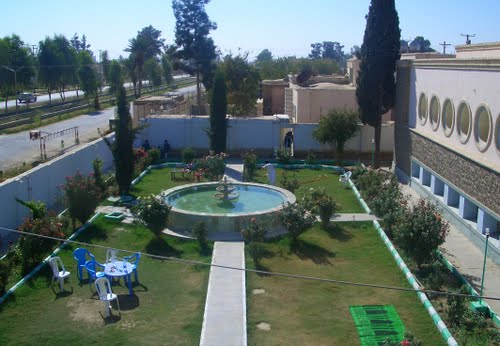Lashkar Gah (Pashto: لښکرګاه) (Persian: لشکرگاه), historically also called Bost, is a city in southern Afghanistan and the capital of Helmand Province, located in Lashkar Gah district. It is situated between the Helmand and Arghandab rivers. Lashkar Gah is linked by highways with Kandahar to the east, Zaranj to the west, and Herat to the north-west. It is mostly very arid and desolate. However, farming does exist around the Helmand and Arghandab rivers. Bost Airport is located on the east bank of the Helmand River, five miles north of the junction of the Helmand and Argahandab rivers.
Lashkar Gah means "army barracks" in Persian. It grew up a thousand years ago as a riverside barracks town for soldiers accompanying the Ghaznavid nobility to their grand winter capital of Bost. The ruins of the Ghaznavid mansions still stand along the Helmand River; the city of Bost and its outlying communities were sacked in successive centuries by the Ghorids, Genghis Khan, and Timur Leng.The great fortress of Bost, Qala-e-Bost, remains an impressive ruin.
I am going to take you on a cyber tour to Lashkar Gah, Helamd Afghanistan. I hope you will enjoy the journey.
Lashkar Gah city is located at 31° 30’ 02″ N, 64° 21’ 24″ E near the convergence of the Helmand and Arghandab Rivers, a half hour's drive south of Lashkar Gah. Qala-e-Bost is famous for its decorative arch, which appears on the 100 Afghani note (Afghan currency). As of April 2008, it was possible to descend into an ancient shaft about 20 feet across and 200 feet deep, with a series of dark side rooms and a spiral staircase leading to the bottom. In 2006 construction began on a cobblestone road to lead from the south of Lashkar Gah to the Qala-e-Bost Arch (known to readers of James A. Michener's Caravans as Qala Bist.
The Helmand river is the longest in Afghanistan with a length of 1,150 km. The river originates in the Hindu Kush and ends in Hamun-i-Helmand in the Sistan and Baluchistan province of Iran. One of the two primary arms of the river crosses through Lashkar Gah, giving it the attractive air of a riverside city. It makes for a pleasant setting for the citizens of Lashkar Gah to picnic. The river is deep enough at Lashkar Gah to allow for varied water sports, including swimming and boating. Boats are available for hire to the citizens.
The teacher training institute in Lashkar Gah is accepting students to be properly trained and educated as future Afghan teachers. This is not new. The college has been in existence for more than 42 years. What is new, are the teaching certification programs the school now offers.
Football is very popular in Lashkar Gah. The Lashkar Gah football stadium was rebuilt in 2006, and has a capacity of more than 10,000 spectators.
Bost Airport is located on the east bank of the Helmand River in Afghanistan, 5 miles (8.0 km) north of the junction of the Helmand and Arghandab rivers. The Airport was established in 1957 by the cooperation of United States. In 2008, a large project commenced to rehabilitate the current airport as well as make an industrial and agricultural park. The overall budget of this project was US$52 million donated by USAID. On 4 June 2009, the new runway and terminal were inaugurated by a delegation of high government officials and the Ambassadors of the US and UK. The new asphalt runway is 2,300m long and 43m wide which takes makes it the third longest runway in Afghanstan. Currently Ariana Afghan Airlines has regular flights between Lashkar Gah and other cities.
The great fortress of Bost, Qala-e-Bost, remains an impressive ruin. It is located at 31° 30’ 02″ N, 64° 21’ 24″ E near the convergence of the Helmand and Arghandab Rivers, a half hour's drive south of Lashkar Gah. Qala-e-Bost is famous for its decorative arch, which appears on the 100 Afghani note (Afghan currency).
Mirwais Neka Park was recently built on the banks of the river. There is a large thicket located on the opposite side of the river from the city. Many types of trees and different species of birds, mammals, and reptiles inhabit the thicket.









































No comments:
Post a Comment